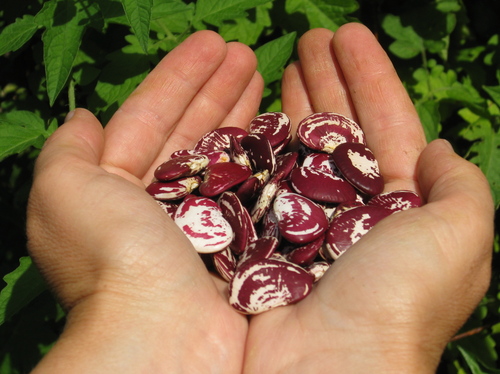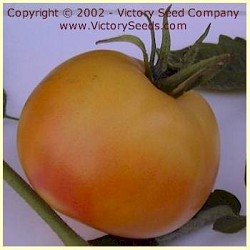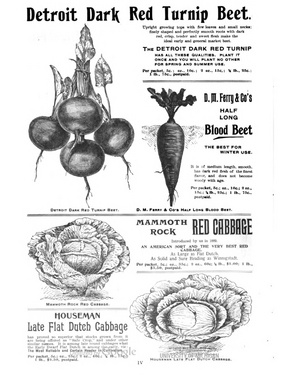Growing place-based heirloom foods takes a community

Christmas Lima Beans - an Ark of Taste heirloom that tastes like chestnuts.
Contributor | Kim Bayer
I've moved on from the gateway drug of garden porn (seed catalogs) to the crack cocaine of the garden world — vegetable seeds. When you imagine yourself eating a tomato warm off the vine in August, it's hard to stop buying seeds of everything you wish you could have right now in April.
I got some free seeds this year because I'm participating in Slow Food Huron Valley's Great Lakes Heirloom Seed Trial.
Slow Food Huron Valley (SFHV) is an all-volunteer, nonprofit local chapter of Slow Food USA, which "seeks to create dramatic and lasting change in the food system by reconnecting Americans with the people, traditions, plants, animals, fertile soils and waters that produce our food."
In addition to events like potlucks, farm tours, film screenings and meet-ups, Slow Food Huron Valley is embarking this year on a community-based seed trial, giving away heirloom seeds in exchange for information about how these particular varieties do in our gardens.
SFHV has gathered the history and planting instructions for 30 varieties of vegetables, from beans and cabbages to tomatoes and squash, that have been grown in the Great Lakes region for more than 60 years.
Many of these were sold through Detroit's D.M. Ferry and Co. Seed Annual from as early as 1894. We're hoping that in addition to tasting great, they also have benefits of adaptation that are characteristic of place-based foods, including resistance to pests and disease, tolerance of the vagaries of our particular climate and a buoyant disposition that results in abundant yields.
What's an heirloom?
I got to help distribute seeds last weekend at the Ann Arbor farmers' market, and one of the most common questions people ask is, "What's an heirloom?" They way I understand it, heirlooms have at least four qualities in common:

Golden Queen - from the Victory Seeds website
2) Heirlooms have been grown and selected since before 1950, when the craze for hybridization began.
3) Heirlooms have been passed down in a family, like any other precious possession from the past.
4) Heirlooms are open pollinated, meaning you can save their seeds and grow the same tasty vegetable next year. You can also intentionally breed your favorite with another to try to create an improved offspring. You cannot do either of these things with hybrids.
Heirlooms are important because their continuous selection over generations makes them treasure troves of genetic strengths and tasty goodness. Because they are open pollinated, we can keep improving them and adapting them to meet the demands of our particular climate zone and taste preferences.
When plants are already resistant to pests and blights, and are drought or heat tolerant, they don't require the chemical inputs or irrigation that others might.
So heirlooms can have important environmental benefits as well as a variety of historic tastes, culinary uses and harvest seasons.
Heirlooms have already been genetically selected over hundreds, even thousands of years by gardeners and growers whose names we'll never know. That genetic information and opportunity for continuous improvement is something we lose if we don't keep planting them and saving their seeds.
For the SFHV seed trial, more than 70 people have signed up to help us figure out which of our 30 Great Lakes Heirloom varieties we should keep on growing and improving!
Among those 70 are several CSA farms (like Capella Farm, Living Stones Farm and brand new Green Things Farm) who are going to be trying out these vegetables on their CSA members. Sunseed Farm and Project Grow Gardens are helping us start seedling tomatoes and peppers too.
Project Grow's Heirloom Plant Sale
Project Grow Gardens, Ann Arbor's nonprofit community gardening organization, has been into heirlooms for a long time. Some of their gardeners have been growing and improving heirlooms for our region for years, coming up with their own new varieties.
And they save seeds! Project Grow's heirloom seeds are on sale now at the People's Food Coop.
If you're into heirlooms, you do not want to miss Project Grow's plant sale. This year it's Saturday, May 21 and Saturday, May 28 from 8 a.m. to 2 p.m. in front of the People's Food Co-op on 4th Avenue in Ann Arbor.
Project Grow will be selling five different kinds of basil, 15 different peppers, and 50 (!!!) varieties of heirloom tomato plants including: German Red Strawberry, West Virginia Hillbilly, Pixie Red Rock, Garden Peach and San Marzano. They also have my all time favorite - Aunt Ruby's German Green.
And this year they're letting people reserve (and pay for) what they want in advance!
Slow Food Huron Valley will be hosting a joint seed saving workshop with Project Grow later on in the summer, as well as organizing an heirloom garden tour and potluck. And look for the Great Lakes Heirloom table at the HomeGrown Festival this year on Sept. 10 at the Ann Arbor Farmers Market.
You can keep up with what's happening with the seed trial through the Great Lakes Heirloom Facebook page, where we'll post upcoming events and updates.
As for moving from catalogs and seeds into hard core planting, I'll have to wait until after Mother's Day to put Aunt Ruby's German Green tomato in the ground. She's a lady from Tennessee that I may try next to Livingston's Golden Queen from Ohio this year. Both of them are listed on the Slow Food Ark of Taste.

From D.M. Ferry and Co.'s 1894 Seed Annual
These scattered warm days of Michigan's early spring have lured me into optimistically planting my first heirlooms already this year — Grand Rapids Lettuce, Scarlet Long Radishes, Dwarf Gray Sugar Peas and Detroit Dark Red Beets.
My inner junior scientist says it's research for the Great Lakes Heirloom Seed Trial. I'm visiting my little rows daily to catch the moment when the first green shoot unfurls against dark soil, telling myself it's so I can record it for a regional gardener's almanac. My inner gardener knows the real reason.
"I used to visit and revisit it a dozen times a day, and stand in deep contemplation over my vegetable progeny with a love that nobody could share or conceive of who had never taken part in the process of creation. It was one of the most bewitching sights in the world to observe a hill of beans thrusting aside the soil, or a rose of early peas just peeping forth sufficiently to trace a line of delicate green. " - Nathaniel Hawthorne, Mosses From An Old Manse
GREAT LAKES HEIRLOOM SEED TRIAL - SEED VARIETIES
Common name, Variety name
Bean, bush, dry, 'Odawa Indian
Bean, pole, snap, 'Black Seeded Kentucky Wonder'
Bean, bush, lima, 'Henderson Bush Lima
Beet, garden, 'Detroit Dark Red'
Cabbage, 'Golden Acre' aka 'Resistant Detroit'
Cabbage, 'Premium Late Flat Dutch', 'Drumhead', 'Surehead'
Corn, sweet, 'Country Gentleman Sweet Corn
Cucumber, 'Green Prolific'
Cucumber, 'Chicago Pickling'
Lettuce, leaf, 'Grand Rapids'
Lettuce, leaf, 'Sanguine Amerliore', 'Strawberry Cabbage Lettuce'
Lettuce, leaf, 'Sunset'
Lettuce, head, 'Hanson Improved'
Melon, muskmelon, 'Honey Rock', 'Sugar Rock'
Melon, 'Emerald Gem'
Melon, 'Hearts of Gold'
Pea, garden, 'Dwarf Gray Sugar'
Pepper, sweet, non-bell, 'Sheepnose Pimento'
Pepper, sweet, 'Miniature Yellow Bell'
Radish, 'Cincinnati Market', 'Long Scarlet'
Squash, winter, 'Chicago Warted Hubbard'
Squash, winter, 'Burgess Buttercup'
Tomato, 'Golden Queen'
Tomato, green 'Tasty Evergreen'
Tomato, yellow pear, 'Beam's Yellow Pear'
Tomato, 'Stone'
Tomato, paste, 'Amish Paste Tomato'
Tomato, 'Kellogg's Breakfast'
Kim Bayer is a freelance writer and culinary researcher. Reach her at kimbayer@gmail.com.

